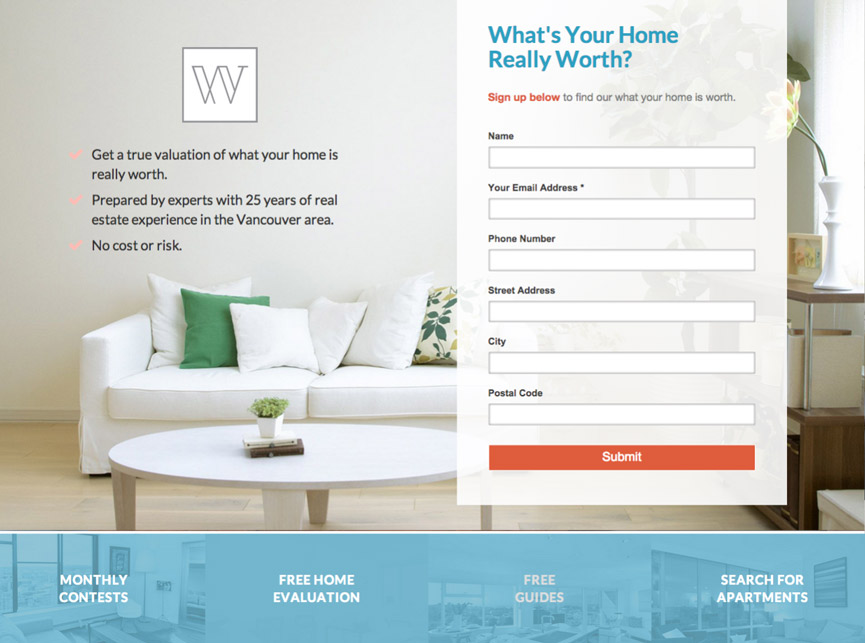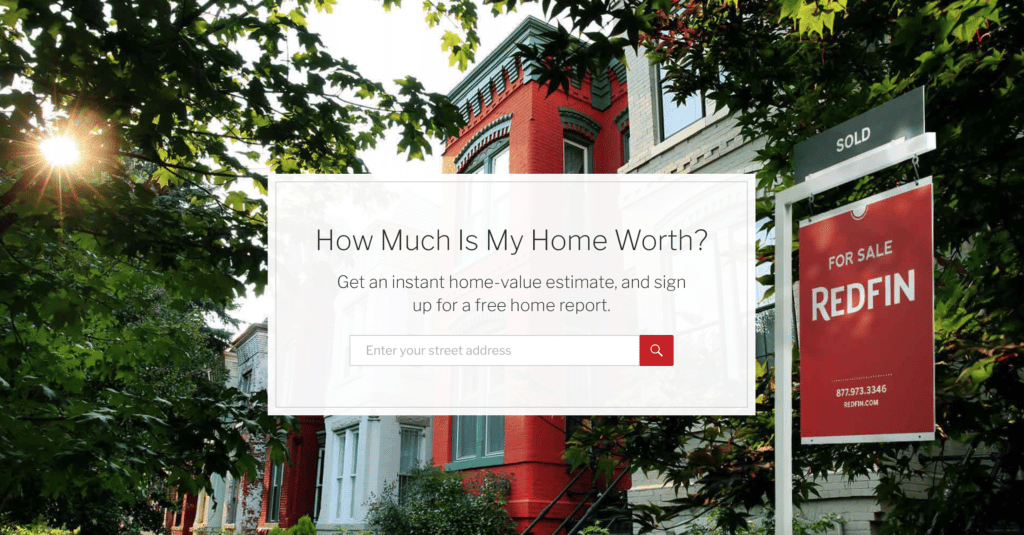Being a real estate agent is tough. You’re juggling a ton of moving parts between hosting open houses, managing listings, and keeping clients happy along with managing your marketing efforts.
Real estate landing pages should be visually compelling and give visitors the information they want immediately. This is a competitive industry that depends on web traffic to succeed and without great landing pages to guide incoming leads toward action, you could be sabotaging your bottom line.
What is a Real Estate Landing Page?
A real estate landing page, just like any other landing page, is a standalone landing page that aims to convert website visitors into leads by collecting their contact information in exchange for valuable information.
In real estate, that valuable information typically takes on of three forms:
- Home Value Landing Page: Home value landing pages are a resource that prospective sellers can use to get an estimate of their home’s value in exchange for their contact information. There are two different types of valuation pages–instant valuation, which provides users with a valuation on the spot, based on an algorithm.The benefit here is, you’ll likely get more conversions than you might with a delayed valuation page, where users receive their estimate in their inbox. While fewer people are likely to convert with a delayed valuation, the benefit is that visitors receive more accurate information, and you’ll receive a more qualified lead.
- Free Content Landing Page: This might be a market report, a guide for listing your home, or an introduction to home financing options for first-time buyers.
- Home Search Landing Page: The home search landing page provides a point of entry for buyers who want to begin the process of finding their new home.In this case, buyers are likely visiting your site because they’re not working with an agent yet and might not be ready to jump into the process. Here, the goal is to get users to sign up for access with their contact information, so you can market to them later.
Embrace Visuals
Real estate lingo on its own sounds a bit boring. Listing descriptions don’t exactly conjure up images of your dream home and everything it represents, right? As such, it’s important to understand that the images you choose for your landing page are just as important, if not more important, than your copy or call to action.
When you select images for your landing pages, make sure you opt for high-quality photos that represent real listings. This example delivers a nice aesthetic, while at the same time, presents a blank canvas for potential sellers just starting to consider the idea of moving.

In this example, Compass uses video to show prospective sellers what it’s like to work with its agents and does a nice job showing visitors the kind of hands-on guidance it provides.

Or, there’s this example from Redfin. We like how they have a clean and clear call to action while using an intrigue-oriented question. These type of prompts inspire the visitor to take action, and are sometimes just what you need to get someone to fill out the form. It’s also limited to just an email field, which should help reduce friction and offers a low barrier to entry.
Focus on Providing a Clear Offer
In this example from Outdoor, the headline doesn’t waste any time getting straight to the point. While the copy could be a bit snappier, clarity beats cleverness; users immediately know what the landing page is about:

“Get an offer on your home with the press of a button.” We like how the text pops against the bright blue background, as well as the simplicity of the opt-in.
Turn Real Estate Landing Pages into a Personalized Experience
Real estate spans a wide range of buyer personas, each expecting an experience relevant to them. While it may sound time-consuming to create multiple landing pages, personalization is super important here. Individuals looking for a vacation home versus first-time home buyers expecting their first child or older buyers hoping to sell their house and downsize all have a different set of needs.
The more specific you can make these landing pages, the better, as platforms like Facebook and Google allow you to get really granular with your targeting efforts (though real estate does have more regulations than say, e-commerce). This means you have the chance to target people based on very specific criteria and can build landing pages designed to get them to take action based on those needs.
In this example from Apartment List, personalization begins with a quiz. We like the simplicity of the form, which allows users to start filtering search results based on what they’re looking for, the number of bedrooms, price range, neighborhood, and whether you’re looking for a place near work or school, as well as your expectations for laundry accommodations. They also include this question, which helps them determine user intent.
While this process involves a long list of questions, it’s an effective tool for collecting qualified leads versus potential renters who are “just looking.”
Build Campaigns Around Answering FAQs
Look, the intent is central to the success of any real estate digital marketing strategy. Why not capitalize on this by using your landing page campaigns to reach people looking for the information you have? Build ad campaigns (on social or Google Ads) that ask questions like “How much is my home worth?” or “Can I find a single-story home?”

On the landing page side, make sure you keep the focus tight, offering up one answer at a time. Additional information at this stage is just background noise and only further distracts them from taking action.
In this example, the ad is directed specifically to buyers seeking single-story homes. Post-click, the landing page should focus exclusively on single-story homes, which A: shows visitors they’re in the right place, and B: keeps the focus on completing an action. If we’re to stick with this example, that might mean scheduling an appointment with an agent who can show the user some great one-story homes.
This landing page example from Placester is perfect for answering specific questions like “how do I buy a home?”

As a landing page, Placester does a nice job with the design and follows best practices like using a contrasting CTA button, minimal form fields, and a look inside the guide — it even lets visitors know that the resource is 28 pages long.
Wrapping Up
Your real estate landing pages are a critical piece of any realtor’s lead generation plan. If you’re not directing leads to your landing pages, you’re missing out on opportunities to increase conversions, which, in turn, means more sales and higher commissions.
As you start building your real estate landing pages, it’s vital to gain an understanding of your target market and create unique landing pages and campaigns that speak to different needs. Use short copy, simple, visually engaging design, and stay focused on the action.
If you do all this successfully, you’ll be able to increase conversions and grow your business online, while you’re out and about connecting with buyers and sellers.
Wondering if your real estate website is set up for driving conversions? Book a free 30-minute conversion assessment to receive feedback from the Drift marketing team and we’ll help you get on the right track.
The Ultimate Guide to Email Marketing
Everything you need to know to increase email engagement and start conversations NOW.